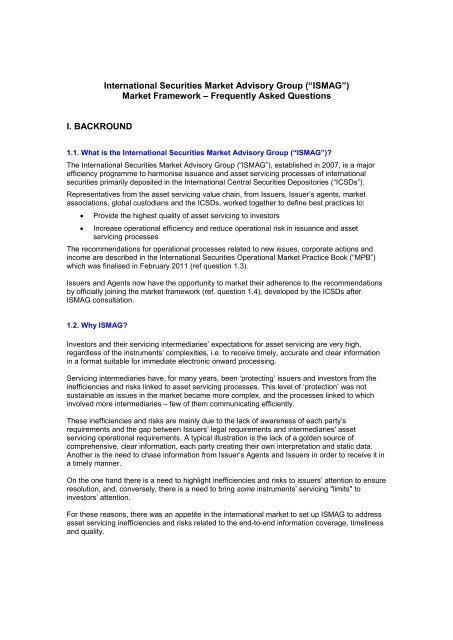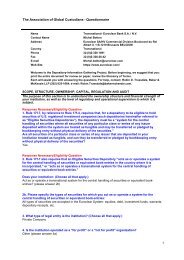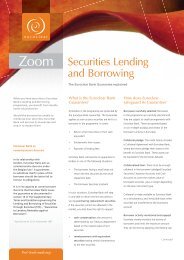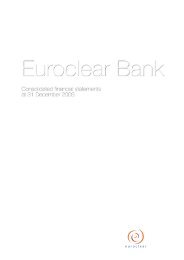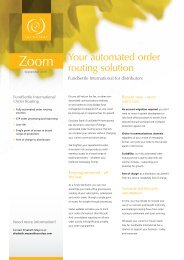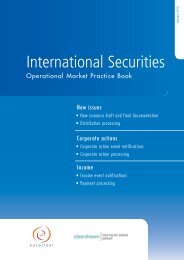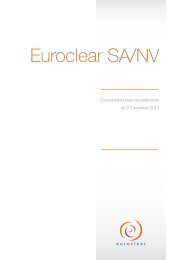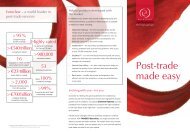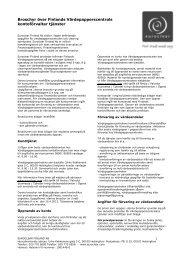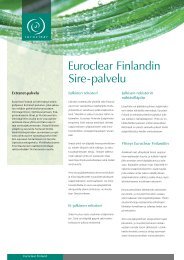FAQ for ISMAG Market Framework - Euroclear
FAQ for ISMAG Market Framework - Euroclear
FAQ for ISMAG Market Framework - Euroclear
Create successful ePaper yourself
Turn your PDF publications into a flip-book with our unique Google optimized e-Paper software.
1.3. What is the “MPB”?The MPB documents the recommendations and current best practices of some best of classparties <strong>for</strong> each of the relevant asset servicing processes, all reached through a collaborative andconsultative ef<strong>for</strong>t in dedicated working groups, one <strong>for</strong> each stream, covering new issues,corporate actions and income processing.The recommendations and best practices describe each market segment’s roles andresponsibilities, “who” needs to do “what” to “whom” and by “when”, to ultimately addresscustodians’ and investors’ needs, while increasing efficiency and reducing risks <strong>for</strong> all parties inthe servicing chain. The MPB also helps clients improve their understanding of the whole ’behindthe scenes’ process involved in servicing their securities.Among the recommendations the MPB includes prescriptions <strong>for</strong>:• timely provision of draft, final and amended new issues documentation, <strong>for</strong> bothstandalone and securities issued under programme,• syndicated new issues closing requirements <strong>for</strong> same day settlement,• corporate action event notification and processing,• income event notifications and processing, and,• the <strong>ISMAG</strong> taxonomy – a set of in<strong>for</strong>mation checklists and specific draftingrecommendations <strong>for</strong> issue documentation and event notifications.These “bottom-up” recommendations are complementary to top-down recommendations issuedon a European level, the Corporate Actions Joint Working Group, operated under the auspices ofCESR), and globally, the ISSA Global Corporate Actions Principles.For an overview of the best practices – please refer to the MPB chapter 1.2 <strong>ISMAG</strong> BestPractices Summary.1.4. What is the <strong>Market</strong> <strong>Framework</strong>?At the beginning of March 2011, the ICSDs launched a new market framework to foster marketadherence, mainly by upstream parties, i.e. Issuers, their legal counsels, servicing agents, etc., tothe recommendations described in the MPB.The framework was developed to:• Improve market per<strong>for</strong>mance, service quality and reduce risks in the issuance and servicing ofinternational securities,• Increase market transparency towards both investors and issuers.The framework combines two axes, ‘adherence’ and ‘compliance’.o Issuers and their agents have the opportunity to voluntarily acknowledge their adherence tothe MPB recommendations by providing the respective Letter of Representation (LoR) to bothICSDs.o Effective adherence and compliance to the MPB recommendations will be monitored by a setof Key Per<strong>for</strong>mance Indicators (“KPIs”), measured against pre-defined benchmarks, as set outin the MPB.
1.5. <strong>ISMAG</strong> – In summary - What’s in it <strong>for</strong> …?• Issuers?¸ Increased Investors’ satisfaction¸ Attractive and competitive issuance model to expand Investor base¸ Better servicing and increased efficiency, leading to reduced costs and risks• Issuer agents and servicing intermediaries?¸ Improved service level towards Investors and Issuers,¸ Attractive issuance model to expand Investor base¸ Better cost control in a volume increasing and complex environment¸ Better risk controls through increased efficiency and standardisation¸ Improved and increased communication amongst various market players• Investors?¸¸Improved service levels in asset servicing, i.e. timely, complete and accurate in<strong>for</strong>mation& processingIncreased transparency on their assets per<strong>for</strong>mance/structure (e.g. “<strong>ISMAG</strong> Adherent”labels)1.6 Is <strong>ISMAG</strong> an ICSD initiative?The initiative is market-driven, sponsored by the ICSDs, but with representatives from allprocessing roles around the table. Collaboratively, these parties defined the recommendationscontained in the <strong>Market</strong> Practice Book. The Project Management Office (PMO) role is per<strong>for</strong>medby representatives from both ICSDs, who continue to report to the <strong>ISMAG</strong>.II. MARKET FRAMEWORK – ADHERENCE2.0. Why is a market framework necessary?Having defined the recommendations, the <strong>ISMAG</strong> has to ensure the recommendations are, firstly,well known in the international securities market by all Issuers and their Agents, across alllocations, and secondly, correctly applied.Indeed, through the market framework, the ICSDs will be able to increase awareness of therecommendations to a wider audience, and additionally we will be able to monitor the complianceagainst the recommendations. The market framework is similar to others already existing, e.g.DTCC in the U.S. apply a similar approach applicable to their procedures, which is supported bythe U.S. Securities and Exchange Commission.2.1. Why should an issuer adhere to the framework?The Issuer can market its engagement to implement the MPB recommendations to its newlyissued securities in order to improve asset servicing quality provided to its investors. This can bedone by sending an Issuer Letter of Representation (LoR) to both ICSDs. The Issuer has thepossibility to submit representations <strong>for</strong> all its future issued securities or <strong>for</strong> a specific programmeand its future drawdowns.Those securities will be awarded an “<strong>ISMAG</strong> Adherent” label available online to the investorcommunity on both ICSDs’ websites.
Issuers also have the possibility to highlight specific securities’ structures that may preventcalculation agents to provide in<strong>for</strong>mation as per the defined benchmarks (i.e. fixing/determinationdate) by assigning such securities with an “<strong>ISMAG</strong> Exempt” label, thereby excluding them fromthe timeliness of rate fixing notifications benchmark measurement.Both “<strong>ISMAG</strong> Adherent” and "<strong>ISMAG</strong> Exempt" labels <strong>for</strong> newly issued securities will bringtransparency:¸ to Investors on their securities portfolio and related expected service levels, being in linewith MPB recommendations, and,¸ to Issuers on their securities’ compliance vis-à-vis the best practices, in other words howtheir various Agents are per<strong>for</strong>ming and ultimately servicing the Investor.2.2. How will the ICSDs publish “<strong>ISMAG</strong> Adherent” Issues?As soon as an Issuer LoR is received by both ICSDs, the issuer’s entity name will be publishedon the respective websites, either <strong>for</strong> all securities or <strong>for</strong> a specific securities programme, from aspecified date.The differentiation of adherence coverage will be done at the level of the security codes in therespective securities’ databases with:• “<strong>ISMAG</strong> Adherent” label if an Issuer LoR has been received• “<strong>ISMAG</strong> Exempt” label in case an exception notification has also been received.The relevant labels will be published on the respective ICSDs’ websites, except if securities aredefined as “confidential” by the lead manager.If no Issuer LoR is received, no ‘<strong>ISMAG</strong>’ labels will be assigned.2.3. What do the different <strong>ISMAG</strong> label values mean?• A security with an <strong>ISMAG</strong> Adherent label means that its issuer has engaged toimplement MPB recommendations by providing an Issuer LoR. Per<strong>for</strong>mance of thesecurities will be monitored against pre-defined benchmarks.• A security with an <strong>ISMAG</strong> Exempt label means that its issuer has engaged to implementMPB recommendations by providing an Issuer LoR, except that <strong>for</strong> this specific security,where the timeliness of rate fixing notifications from the calculation agent to the payingagent are not possible within the prescribed timeline of fixing/determination date + 1business day, given the specific structure of the security. Investors shouldn’t expect toreceive the variable rate in<strong>for</strong>mation within that benchmark and <strong>ISMAG</strong> exempt securitieswill not be included in income rate timeliness KPI monitoring.• A security without an ‘<strong>ISMAG</strong>’ label could mean that:ooothe security is not primarily deposited in the ICSDs, so the LoR is not applicable,or,the securities were issued be<strong>for</strong>e May 2011, so the <strong>ISMAG</strong> label is de-facto‘blank’ as the framework is only applicable to newly issued securities, or,<strong>for</strong> securities issued after May 2011, it will mean that no Issuer LoR has beenreceived yet or that the Issuer has provided LoR <strong>for</strong> some of its newly issuedsecurities, but not on a ‘blanket’ basis, i.e. <strong>for</strong> all newly issued securities.
2.4. Why should an Issuer’s Agent adhere to the framework by sending an Issuer AgentLetter of Representation (LoR) to both ICSDs?By doing so, the Issuer’s Agent will market its engagement to implement ‘best of class’ practicesdescribed in the MPB on securities it does/will service.The Issuer’s Agent relates to any capacity it may play, e.g. Paying Agent, Issuing and PayingAgent, Fiscal Agent, Corporate Action Agent, Calculation/Determination agent, Lead Manager,Arranger, Dealer, Legal Counsel, etc. They have the option to provide a blanket letter <strong>for</strong> theirrelevant role that will be applicable <strong>for</strong> all <strong>ISMAG</strong> labelled securities it (will) service.As soon as an Issuer Agent LoR is received, this agent’s entity name will be published on bothICSDs’ websites, but not directly linked to any specific Issuers’ securities.2.5. If the Issuer sends an Issuer LoR, but one or more of the Agents does not send anIssuer Agent LoR will the Securities still be ‘<strong>ISMAG</strong>’ labelled’?Yes. The ICSDs will assign the “<strong>ISMAG</strong>” label based on the Issuer’s LoR.The ICSDs will not reconcile that each or every relevant servicing agent has signed an IssuerAgent LoR. As such, the Issuer will need to monitor this with its’ agents and take relevant actionsto create the conditions <strong>for</strong> its’ agents to be able to comply with the applicable recommendationsas noted in the LoR.2.6. Does the Issuer or Issuer Agents’ LoRs create specific legal obligations on adherentIssuers and Issuer Agents?As stated in each LoR, “this is not legally binding nor en<strong>for</strong>ceable nor does it create anycontractual relationship” between signing parties. The LoR itself is a commitment, an engagementof the Issuer and/or it’s Agents which might be, at each parties’ discretion, reflected in underlyingcontractual arrangements.2.7. Could agreeing to implement MPB recommendations through Issuer Agent LoR createinconsistency, uncertainty and increase exposure in such instances with Agent’sobligations set out in their legal documentation with Issuers?Issuers might decide to change their programme documents, term sheets, final terms, etc., andperhaps also amend agency or service level agreements to enable all their agents to implementrecommendations detailed in the MPB.The purpose of the MPB is to document current end-to-end best practices that increase efficiencyand reduce risks <strong>for</strong> all servicing intermediaries, especially <strong>for</strong> Issuer Agents, so it shouldn'tcreate inconsistency, uncertainty nor increase exposure, but the contrary.2.8. By signing the LoR, Issuers and their Agents are agreeing not only to comply with theversion of the MPB as at that date (currently February 2011) but also automatically toamendments from time to time?Updates will not be carried out without prior notification and consultation with the <strong>ISMAG</strong>. Futurechanges should be very limited to ensure accuracy and adequacy of the MPB recommendationswith future asset servicing requirements or regulatory changes.
2.9. Can Issuers and/or Issuer Agents cease their LoR engagements?Should Issuers and/or their Agents wish to cease their practice of complying with the MPB, eitherin whole or in part, a Revocation Request should be provided to both ICSDs. Any labels assignedto securities or agents will then be removed.2.10. Could the voluntary market framework adherence become mandatory?Adherence could become mandatory by the end of 2012 should the adherence level of newlyissued securities in 2011 be below 50% at the end of 2011. This is the reason why marketawareness is so important in 2011 and why <strong>ISMAG</strong> needs the support of all international marketplayers to promote the recommendations to high volume issuers and their agents.The exact basis <strong>for</strong> the mandatory scheme is still to be defined, i.e. explicit with an Issuer LoR (as<strong>for</strong> DTCC eligibility) or implicit (de-facto) by requiring ICSD's eligibility, an Issuer will be deemedto have signed the issuer LoR <strong>for</strong> all newly issued securities, also seen in DTCC.2.11. What is the <strong>Market</strong>’s view on the framework?<strong>Market</strong> and <strong>ISMAG</strong> members are supportive on the principle to improve market per<strong>for</strong>mance byfostering implementation of best practices, but there are divergent views on how these principlesshould be applied. The PMO presented the ICSDs’ view to the Members <strong>for</strong> the ‘starting point’ inthe framework during their February 2011 meeting and is addressing the concerns and pointsraised in this and subsequent discussions.That said, there is an agreement in place and respective Letters of Representation have beensigned beginning of May 2011 by:* issuers’ agents:BNP Paribas Securities Services, LuxembourgCiti Agency & Trust (GTS), LondonLucid Issuer Services LimitedBondholder Communications Group LLC* issuersEuropean Investment Bank (EARNs Programme)KfW announced their support and will sign their LoR when their yearly programme update iscomplete.Other Issuers and Agents are undertaking a review of the respective letters with a view toproviding signed versions in the near future.The PMO welcomes feedback from the wider Issuing and Agent community on the content of theletters to enable them to create a more widely acceptable content whilst still in the voluntaryphase.The PMO continue to discuss with Issuers, Agents and legal counsels globally, to promote the<strong>ISMAG</strong> recommendations, <strong>Market</strong> Practice Book and the market framework <strong>for</strong> wider adoption.III. MARKET FRAMEWORK – COMPLIANCE3.1. Which KPIs are monitored?
Currently, there are 3 KPIs <strong>for</strong> which specific yearly targeted benchmarks have been defined by<strong>ISMAG</strong>. Those are:1. The receipt, by the ICSDs, of the securities’ final documentation by issue/closing date + 1Business Day (from the Issuing & Paying Agent in case of issuance under programme orfrom the Lead Manager <strong>for</strong> securities issued on a stand alone basis);2. The receipt, by the Paying Agent, of the rate fixing notification, at the latest onfixing/determination date + 1 Business Day from the Calculation Agents;3. The number of reversals and their detection timing after the payment date by thereversals originator.The levels of compliance will not be made public.3.2. How will compliance against the KPIs be monitored?There are multiple agents appointed on a security and how each agent is assessed based on itsparticular agency role, especially where one agent relies on another, or where an agent relies onthe Issuers per<strong>for</strong>mance is unclear.It is important to have a significant adherence level in the market as it reflects the engagement ofthe different parties. More importantly, this engagement must translate into improved behaviourand per<strong>for</strong>mance of the relevant securities, leading to a higher level of investor satisfaction.Each downstream party should monitor its upstream counterpart <strong>for</strong> <strong>ISMAG</strong> labelled securities toensure adequate awareness and implementation of the MPB recommendations. The purpose isto move from a in<strong>for</strong>mation "pull model" from downstream parties, to a "push model" fromupstream parties to increase in<strong>for</strong>mation coverage, timeliness and accuracy.Each party will be monitored <strong>for</strong> its own responsibility. As such, KPIs are built to monitor the"originator" of in<strong>for</strong>mation, e.g. Calculation Agent per<strong>for</strong>mance is monitored by Paying Agents <strong>for</strong>the timeliness of rate fixing, Lead Managers or Issuing and Paying agents are monitored by theICSDs <strong>for</strong> the final documentation availability, etc.3.3. How will KPI results be aggregated to assess ‘<strong>ISMAG</strong>’ compliance?KPI results will not be aggregated; each KPI will be monitored distinctly vis-à-vis the MPBrecommendations and the targeted benchmarks.3.3. What are the potential implications of under per<strong>for</strong>ming compliance levels <strong>for</strong>adherent Issuers and Agents?Reporting will be established to adherent Issuers on their <strong>ISMAG</strong> labelled securities per<strong>for</strong>mancevis-à-vis the MPB recommendations and the targeted benchmarks. The same will be done withrelevant servicing Agents, and where necessary, follow-up tripartite discussions will take place todevelop action plans to further improve per<strong>for</strong>mance against the KPI benchmarks.The level of compliance will only be shared with relevant Issuers and Agents to providetransparency on their respective per<strong>for</strong>mance levels in order to improve their servicingper<strong>for</strong>mance and quality towards investors. The levels of compliance will not be made public.
In case the KPI results are systematically below the yearly pre-defined benchmarks, i.e. <strong>for</strong> morethan 3 quarterly periods (9 months), and no clear action plan is shared by the Issuer and/or theirAgents to improve per<strong>for</strong>mance, the following measures might be taken by the ICSDs:- Issuers/Agents names removed from the published list of <strong>ISMAG</strong> adherent parties, and/oreither,a) removal of <strong>ISMAG</strong> Adherent label on each security, or,b) replacement of <strong>ISMAG</strong> Adherent label with a “non-compliant” label. This remains a very lastresort as the purpose is not to ‘name and shame’ nor harm issuers’ reputations.IV. ADDITIONAL INFORMATIONFor further in<strong>for</strong>mation, please consulto ICSDs websites on: www.euroclear.com/<strong>ISMAG</strong> and www.clearstream.com/<strong>ISMAG</strong>o The International Securities Operational <strong>Market</strong> Practice Book (MPB)o <strong>ISMAG</strong> PMO Teams on ismag.pmo@euroclear.com and ismag_pmo@clearstream.comThe <strong>ISMAG</strong> PMO is at your disposal to further clarify any questions and help you to “spread” theMPB recommendations within your organisation and with your relevant external contacts (e.g.Clients, Issuers, Agents, etc.)


